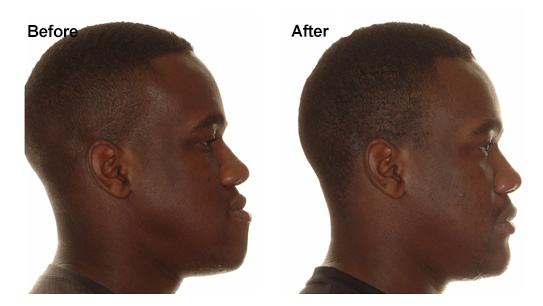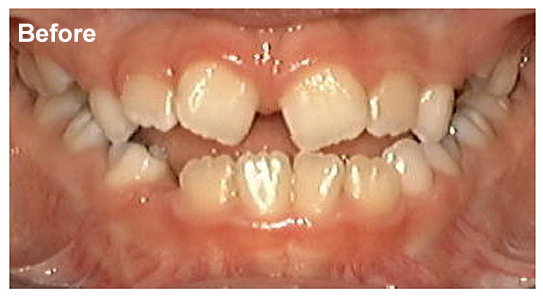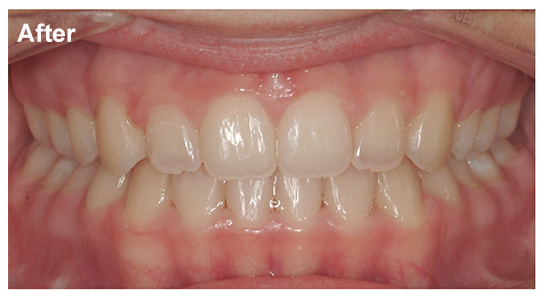January 16th, 2018

LOWER JAW SURGERY, called a bilateral sagittal split osteomy (BSSO), can move your lower tooth jaw position either forward or backward to improve both your facial appearance and your bite.
Why Jaw Surgery?
Lower jaw growth is greatly influenced by genetics and often cannot be controlled. If you have a large lower jaw (mandibular prognathism), you may benefit in facial appearance and tooth function by having your lower jaw moved back. This is called a mandibular setback.

This procedure has many benefits, including:
- The lower jaw can be moved as desired to the ideal position
- Nothing shows outside of your mouth. Rigid Intraoral Fixation (RIF) tiny titanium plates are used so your jaw doesn’t need to be “wired shut” during healing
- Postsurgical healing is quick and stability is good


The chin can also be repositioned. This procedure is called a genioplasty. It is also done in about 30% of jaw surgery patients.

Is Jaw Surgery Right For You?
In Northern California, the cost of orthognathic surgery (jaw surgery) is usually covered by medical insurance. Many patients have their jaw surgery treatment done at either Oakland Kaiser Hospital or UCSF Medical Center.
If you have questions regarding jaw surgery, call us at Gorczyca Orthodontics in Antioch, California at (925) 757-9000. Board certified orthodontist Dr. Ann Marie Gorczyca has been treating jaw surgery patients successfully for over 30 years. Visit us for a complimentary orthodontic examination and let us help you get the bite and facial appearance of your dreams.
Jaw surgery can save your smile. It can also improve your life.
The content on this blog is not intended to be a substitute for professional medical advice, diagnosis, or treatment. Always seek the advice of qualified health providers with questions you may have regarding medical conditions.
Tags: orthodontist, orthodontics, braces, jaw surgery, genioplasty, prognathism, mandibular prognathism, BSSO, rigid fixation, RIF, big lower jaw
Posted in Blog | No Comments
August 25th, 2015

WITHIN FAMILIES, it’s obvious that facial features are hereditary. The best known example is the Habsburg Family, a royal family with large lower jaws.
Anterior crossbites, openbites, or both are seen in parents and grandparents, aunts and uncles, siblings, and cousins of large lower jaw patients. Inheritance is strong. In a recent study, the heritability of mandibular prognathism (large lower jaw) was estimated to be 0.316 and autosomal dominant, suggesting a major gene influences large lower jaw growth.

Large lower jaws are present as early as age 7. This is why when your orthodontist sees an underbite or openbite with a large lower jaw, they will do an in-depth analysis of jaw growth as well as take a careful family history for large lower jaw, called Class III skeletal malocclusion.

Genetically programmed large lower jaw growth cannot be prevented. Maxillofacial surgeons have been doing large lower jaw surgery for decades and often do several hundred per year. This surgery may be done at age 16 in females and age 21 in males. Your orthodontist can take a hand-wrist film to look at radius bone growth completion to determine the best time for orthognathic surgery (jaw surgery).

This case was treated by board certified orthodontist Dr. Ann Marie Gorczyca of Gorczyca Orthodontics, Antioch, CA. Find us at www.clubbraces.com or call us at (925) 757-9000 to schedule a complimentary jaw assessment.
Find out if you have the royal jaw. If you would like a commoner smaller lower jaw, we're here to help.
Tags: openbite, anterior crossbite, Class III, maxillary advancement, orthognathic surgery, large lower jaw, prognathism, mandibular prognathism, skeletal class III, Class 3, Underbite, maxillofacial surgeon, mandibular setback, hand wrist film, skeletal malocclusion
Posted in Blog | 1 Comment
















